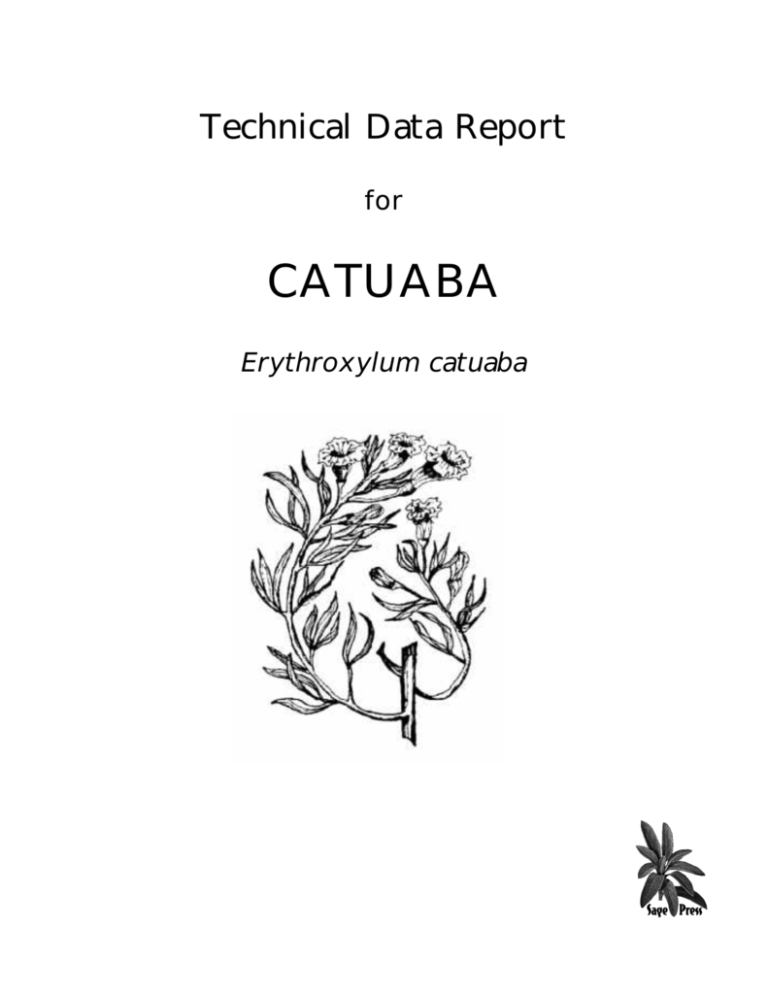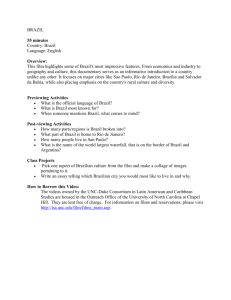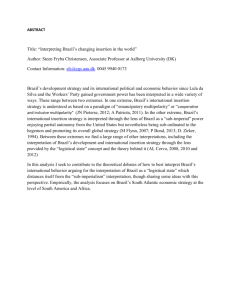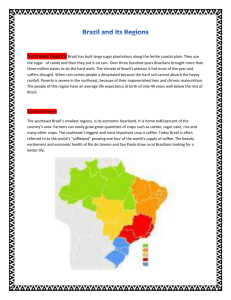
Technical Data Report
for
CATUABA
Erythroxylum catuaba
All rights reserved. No part of this document may be reproduced or transmitted in any form or by any means,
electronic or mechanical, including photocopying, recording, or by any information storage or retrieval
system, without written permission from Sage Press, Inc.
This document is not intended to provide medical advice and is sold with the understanding that the publisher
and the author are not liable for the misconception or misuse of information provided. The author and Sage
Press, Inc. shall have neither liability nor responsibility to any person or entity with respect to any loss,
damage, or injury caused or alleged to be caused directly or indirectly by the information co ntain ed in this
document or the use of any plants m entioned. Readers s hould not use any of the products disc ussed in this
document without the advice of a medical professional.
© Copyright 2003 Sage Press, Inc., P.O. Box 80064, Austin, TX 78708-0064. All rights reserved.
For additional copies or information regarding this document or other such products offered, call or write at
sagepress@sbcglobal.net or (512) 506-8282.
Catuaba
Preprinted from Herbal Secrets of the Rainforest, 2nd edition, by Leslie Taylor
Published and copyrighted by Sage Press, Inc., © 2003
Fam ily: Erythroxylaceae
Genus: Erythroxylum
Species: catuaba
Other Sp ecies: Trichilia catigua, Juniperus brasiliensis, Eriotheca candolleana, Anemopaegma
mirandum
Common Names: Catuaba, cataguá, chuchuhuasha, tatuaba, pau de reposta, caramuru,
piratançara, angelim -rosa, catiguá
Part Used: Bark
Erythroxylum catuaba is a vigorous-growing, small tree that produces yellow and orange flowers
and small, dark yellow, oval-shaped, inedible fruit. It grows in the northern part of Brazil, the
Am azon, Para, Pernambuco, Bahia, Maranhao, and Alagoas. This catuaba tree belongs to the
family Erythroxylaceae, whose principal genus, Erythroxylon, contains several species that are
sources of cocaine. Catuaba, however, contains none of the active cocaine alkaloids.
A large amount of confusion exists regarding the actual species of tree that is harvested in
Brazilian forests and sold around the world as catuaba. Experienced Brazilian harvesters will refer
to two species: a “big catuaba” and a “small catuaba.” The confusion thickens when relating these
trees to approved botanical species names. “Small catuaba” is Erythroxylum catuaba (A. J. Silva
ex. Raym.-Hamet —the name was accepted in 1936), which grows 2–4 m tall and sports yellow-toorange flowers and—in Brazil—is referred to as catuaba. “Big catuaba,” in the mahogany family,
is Trichilia catigua (A. Juss.), which grows 6–10 m tall, has cream -colored flowers and—in
Brazil—is referred to as catiguá and angelim-rosa. Moreover, three other (unapproved) botanical
names for catuaba are used incorrectly in herbal comm erce today: Juniperus brasiliensis (which
is thought to refer to “small catuaba”), and Anemopaegma mirandum and Eriotheca candolleana,
which are completely different species altogether. Anemopaegma is a huge tree in the Bignonia
family, growing to 40 m tall and called catuaba-verdadeira in Brazil. This species of tree is now
harvested and exported out of Brazil (resulting in the incorporation in herbal products sold in the
U.S. today) as just "catuaba." Erythroxylum catuaba and Trichilia catigua are the preferred Brazilian
herbal medicine species, with the longest docum ented history of use as “big and little catuaba.”
Both types are used interchangeably in Brazilian herbal medicine systems for the same conditions.
Catuaba has a long history of use in herbal medicine as an aphrodisiac. The Tupi Indians
in Brazil first discovered the aphrodisiac qualities of the plant; over centuries they have composed
many songs praising its wonders and abilities. Indigenous and local peoples have used catuaba
for generations. It is the most famous of all Brazilian aphrodisiac plants. In the Brazilian state of
Minas there is a saying, “Until a father reaches 60, the son is his; after that, the son is catuaba’s!”
In Brazilian herbal medicine today, catuaba is considered a central nervous system
stim ulant with aphrodisiac prope rties; a bark decoction is used for sexual im potency, agitation,
nervousness, neurasthenia, poor memory or forgetfulness, and sexual w eakness. According to Dr.
Meira Penna, catuaba “functions as a stimulant o f the nervous system, above all when one deals
with functional impotence of the male genital organs . . . it is an innocent aphrodisiac, used without
any ill effects at all.” 1 In Brazil it is regarded as an aphrodisiac with “proven efficacy” and, in addition
to treating im potence, it is em ployed for many types of nervous conditions including insomnia,
hypochondria, and pain related to the central nervous system . In European herbal medicine
catuaba is considered an aphrodisiac and a brain and nerve stimulant. A bark tea is used for sexual
weakness, impotence, nervous debility, and exhaustion. Herbalists and health practitioners in the
1
United States use catuaba in much the same w ay: as a tonic for genital function, as a central
nervous system stimulant, for sexual impotence, general exhaustion and fatigue, insomnia related
to hypertension, agitation, and poor memory. According to Michael van Straten, noted British
author and researcher of medicinal plants, catuaba is beneficial to men and women as an
aphrodisiac, but “it is in the area of male impotence that the most striking results have been
reported” and “there is no evidence of side effects, even after long-term use.” 2
The constituents found in catuaba include alkaloids, tannins, aromatic oils and fatty resins,
phytosterols, cyclolignans, sequiterpenes, flavonoids, and steroids.3–6 One Brazilian researcher
documented (in 1958) that catuaba contained the alkaloid yohimbine (but it was unclear which
species of tree he was studying). 3 A mixture of flavalignans, including cinchonains (also found in
quinine bark), was isolated from the bark of Trichilia catigua and reported to have antibacterial and
cytotoxic properties.6,7 To date, no toxicity studies have been done on catuaba—but its long history
of use in Brazil has reported no toxicity or ill effects. In fact, according to Dr. Meira Penna, the only
side-effects are beneficial—erotic dreams and increased sexual desire!
Clinical studies on catuaba also have shown results related to its antibacterial and antiviral
properties. A 1992 study indicated that an extract of catuaba (Erythoxlyum catuaba) was effective
in protecting mice from lethal infections of Escherichia coli and Staphlococcus aureus, in addition
to inhibiting HIV significantly.8 The study found that the pathway of catuaba’s anti-HIV activity
stemmed (at least partially) from the inhibition of HIV absorption into cells, and suggested that
catuaba had potential against opportunistic infections in HIV patients.8 A U.S. patent was granted
(in 2002) to a group of Brazilian researchers for a catuaba bark extract (Trichilia catigua). Its patent
refers to animal studies it conducted that reported a vasodilating, vasorelaxant, and analgesic effect
in rats, rabbits and guinea pigs. 9 A study published in 1997 repo rted that catuaba bark had
significant analgesic activity in vivo.10
W hile no clinical research has validated the traditional use of catuaba as an aphrodisiac,
it continues to be used widely for its ability to enhance sexual drive and increase libido in both men
and women. In the last several years, its popularity has grown in the North American herbal market,
with various products now available in health food stores. (The jury’s still out as to which species
is being sold, however!) Interested consumers should seek a reputable manufacturer and
product—with a verified plant source and botanical species for the herbal ingredient being sold.
Documented Properties and Actions: Analgesic, antibacterial, antiviral, aphrodisiac, central
nervous system stimulant, tonic, vasodilator, vasorelaxant
Main Phytochem icals: Alkaloids, tannins, aromatic oils, fatty resins, phytosterols, cyclolignans,
sequiterpenes, flavonoids, steroids
Traditional Remedy: Generally in Brazil, a standard infusion (bark tea) and an alcohol tincture are
employed. Recommended usage is reported to be 1–3 cups of an infusion daily, or 2–3 ml of a
standard alcohol tincture twice daily.
Contraindications: None known.
Drug Interactions: None known.
2
WORLDWIDE ETHNOBOTANICAL USES
Region
Uses
Brazil
Aphrodisiac, central nervous system stimulant,
exhaustion, fatigue, forgetfulness, frigidity, genitals,
hypochondria, impotence, insomnia, nervousness,
neurasthenia, pectoral, poor memory, sexual weakness,
sleep, syphilis, tonic
Peru
Skin cancer
U.S.
Aphrodisiac, fatigue, impotency, insomnia, nervous
exhaustion, nervous system, poor memory, sleep, tonic,
weakness
Elsew here
Brain, circulation, fatigue, genitals, impotence, low libido,
nervous system
References
1.
2.
3.
4.
5.
6.
7.
8.
9.
10.
Chian, Sing. Cura com Yoga e Plantas Medicinais. Rio de Janeiro: Freitas Bastos, 1979.
van Straten, M. Guarana: The E nergy S eeds and Herbs of the Am azon Rainforest. U.S.(Can you c ite
a city here instead of “U.S.”?): C. W. Daniel Company, Ltd., 1994.
Altman, R. F. A. “Presenca de ioimbina na c atuaba.” Ser. Quim. P ubl. 1958; 1.
Maia, J. G., et al. Estudos Integrados de Plantas da Amazonia. V Simposio de Plantas Medicinais do
Brasil, São Paulo, Brazil, Sep. 6, 1978: 7.
Garcez, W . S., et al. “Sesquiterpenes from Trichilia catigua.” Fitoterapia 1997; 68(1): 87–8.
Satoh, M., et al. “Cytotoxic constituents from Erythroxylum catuaba. Isolation and c yto toxic activities
of cinchonain.” Natural Med. 2000; 54(2): 97–100.
Pizzolatti, M. G ., et al. “Two epimeric flavalignans from Trichilia catigua (Meliaceae) with antimicrobial
activity.” Z. Naturforsch 2002; 57(5–6): 483–88.
Manabe, H., et al. “Effects of catuaba extracts on microbial and HIV infection.” In Vivo 1992 ; 6(2):
161–65.
Sander, P. C., et al. “Pharmaceutical formulations c omprising vegetal material selected from trichilia.”
U.S. Patent no. 6335039; Jan 1, 2002.
Vaz, Z. R., et al. “A nalgesic effect of the herbal medicine Catuaba in thermal and chemic al models of
nociception in mice.” Phytother. Res. 1997; 11(2): 101–6.
The information contained herein is intended for education, research, and informational purposes only. This
information is not intended to be used to diagnose, prescribe or replace proper medical care. The statements
contained herein have not been evaluated by the Food and Drug Administration. The plant described herein
is not intended to diagnose, treat, cure, mitigate, or prevent any disease.
3
Ethnomedical Information on Catuaba (Erythroxylum catuaba)
Part / Location
Documented Ethnic Use
Typ e Extract / Route
Used For
Bark Amazonia
Functions as a male hormone stimulant and tonic for male organs; used for
impotence; to stimulate the nervous system and enhance male libido. Used for
disorders of general weakness and nervous exhaustion.
Infusion Oral
Human A dult
ZZ1016
Bark Amazonia
Said to be excellent for the male reproductive organs, to increase circulation and
libido. Stimulates the nervous system and brain and used for impotence.
Infusion Oral
Human A dult
ZZ1015
Bark Brazil
Used as a brain and nerve stimulant and aphrodisiac for women. Used for sexual
weakness, male impotence, nervous debility and exhaustion.
Infusion Oral
Human A dult
ZZ1011
Bark Brazil
Used to stimulate the nervous system, as a tonic for the genitals, for functional
impotence, as an aphrodisiac and sexual stimulant. Said to increase sexual desire
and cause exotic dreams.
Infusion Oral
Human A dult
ZZ1070
Bark Brazil
Used for sexual impotence, to fortify the nervous system, for neurasthenia, hypochondria, insomnia, nervous affections, as a stimulant and aphrodisiac.
Various Oral
Human A dult
ZZ1013
Bark Brazil
Used a tonic, as an energy stimulant of the nervous system, as an aphrodisiac for
sexual impotence, for agitated sleep, nervousness, neurasthenia, forgetfulness, poor
memory and sexual frigidity.
ETOH E xt Oral
Human A dult
ZZ1002
Bark Brazil
Used as a stimulant, pectoral, antisyphilitic and aphrodisiac.
H2O Ext Oral
Human A dult
ZZ1079
Root Brazil
Used as an aphrodisiac.
Hot H2O Ext Oral
Human M ale
L02535
Root Brazil
Used as a stimulant.
Alcohol Ext Oral
Human A dult
K20642
Root Brazil
Used as an aphrodisiac.
Alcohol Ext Oral
Human M ale
K20642
Not stated Peru
Used for skin cancer.
Not stated External
Human A dult
ZZ1047
Bark USA
Used as a tonic and fortifier of the nervous system, for general fatigue, restless
sleep and insomnia from hypertension, for failing memories. Used as a tonic for the
male organs, for male impotency and as a male aphrodisiac.
Infusion/Tincture Oral
Human A dult
ZZ1014
Bark USA
Used for male impotency, as a tonic for male organs and the nervous system and for
extreme fatigue.
Tincture Oral
Human A dult
ZZ1067
4
Ref #
Biological Activities of Catuaba (Erythroxylum catuaba)
Part – Origin
Activity Tested For
Type Extract
Test Model
Dosage
Result
Notes/Organism tested
Ref #
Bark Brazil
Cytotoxic Activity
EtOH (100%) Ext
Cell Culture
Not stated
Active
LEUK-l1210.
L11339
Bark Brazil
Analgesic Activity
Hydro-alcoholic Ext
IG Mouse
200.0 mg/kg
Active
vs.acetic acid-induced writhing.
J13503
Bark Brazil
Analgesic Activity
Hydro-alcoholic Ext
IG Mouse
200.0 mg/kg
Active
vs.hot plate method.
J13503
Bark Brazil
Analgesic Activity
Hydro-alcoholic Ext
IG Mouse
200.0 mg/kg
Active
vs.tail flick response to radiant
heat.
J13503
Bark Brazil
Analgesic Activity
Hydro-alcoholic Ext
IG Mouse
200.0 mg/kg
Active
vs.capsaicin-induced algesia.
J13503
Bark Brazil
Analgesic Activity
Hydro-alcoholic Ext
IG Mouse
200.0 mg/kg
Weak
Activity
vs.formalin-induced algesia.
J13503
Not Stated
Antimicrobial Activity
Not stated
Not stated
Not stated
Active
Not Stated
Antibacterial Activity
Hot H2O Ext
Alkaline Ext
Mice
Mice
Not stated
Not stated
Active
Active
Protected from lethal infection of
E. coli and S. aureus.
AZ1001
Not Stated
Antiviral Activity
Hot H2O Ext
Alkaline Ext
Mice
IC50=21-263
mcg/ml
Active
Inhibited HIV-induced cytopathic
effect.
Inhibited expression of HIV
antigen in HIV-1HTLV-IIIB or HIV2ROD infected human
lymphotropic virus type 1 positive
MT-4 cells.
Inhibited HIV absorption to cells.
AZ1001
Inhibitory activity on TNF-alphainduced cell death.
AZ1002
Active
Active
Not Stated
Hepatoprotective
Activity
GI = Gastric Intubation
Cinchonain Ia
Fraction
IG = Intragastric
Cell Culture
(mouse
hepatocytes)
IP = Intraperitoneally
Not stated
IV = Intravenously
Active
AZ1003
SC = Subcutaneously
IM = Intramuscular
5
Presence of Compounds in Catuaba (Erythroxylum catuaba)
Compound
Chemical Type
Plant Part
Plant Origin
Quantity
Ref #
Calamenene, 7,14-dihydroxy
Sesquiterpene
Stem
Brazil
00.0008%
L03040
Calamenene, 14-nor: 7-hydroxy-1-oxo
Sesquiterpene
Stem
Brazil
00.002%
L03040
Cinchonain I-A
Flavonoid
Bark
Brazil
00.02919%
L11339
Cinchonain I-B
Flavonoid
Bark
Brazil
00.06649%
L11339
Daucosterol
Steroid
Stem
Brazil
00.002%
L03040
Yohimbine
Alkaloid
Not stated
Brazil
Not stated
AZ1004
6
Literature Cited – Catuaba (Erythroxylum catuaba)
J13503
ANALGESIC EFFECT OF THE HERBAL MEDICINE CATUAMA IN THERMAL AND CHEMICAL MODELS OF NOCICEPTION IN MICE. VAZ,ZR:
MAT A,LV: CALIXTO,JB: PHYTOTHE R RES 11 2: 101-106 (1997) (DEPT F ARM UNIV F ED SA NTA CAT ARINA FLORIAN OPOLIS S C 88049
BRAZIL)
K20642
TRAD ITIONAL AMA ZONIA N NERVE T ONICS AS A NTIDEP RES SAN T AGENTS : CHAUNOCHITO N KAPPLERI: A CA SE S TUDY.
ELIS ABETS KY,E : FIGUE IREDO,W : OLIVERIA ,G: J HE RBS SPICES ME D PLANT S 1 1/2: 125-162 (1992) (DE PT F ARM ACO L UNIV FED RIO
GRANDE DO SUL PO RTO ALE GRE 90 0650 BRAZ IL)
L02535
MEDICAL BOTANY.WILEY-INTERSCIENCE,NEW YORK(1977). LEWIS,WH: ELVIN-LEW IS,MPF: BOOK : (1977) (BOTANY DEPT
W ASHINGTON UNIV ST LOUIS MO USA)
L03040
SESQUITERPENES FROM TRICHILIA CATIGUA. GARCEZ,W S: GARCEZ,FR: RAMOS,L: CAMARGO,MJ: DAMASCENO JR,GA:
FITOTERA PIA 68 1: 87-88 (1997) (DEPT QUIM CCE T UNIV FED M ATO GR OSS S UL CAMP O GRAND E BRAZ IL)
L11339
CYTOTOXIC CONSTITUENTS FROM ERYTHROXYLUM CATUABA ISOLATION AND CYTOTOXIC ACTIVITIES OF CINCHONAIN. SATOH,M:
SATOH,Y: FUJIMOTO,Y: NATURAL MED 54 2: 97-100 (2000) (SHOWA PHARM UNIV TOKYO 194-8543 JAPAN)
AZ1001
EFFECTS OF CA TUABA EXTRACTS ON M ICROBIAL AND HIV INFECTION. MANABE, H: SAKAGAM I, H: ISHIZONE, H: KUSANO, H:
FUJIMAKI, M: WADA, C: KOMATSU, N: NAKASHIMA, H: MURAKAMI, T: YAMAMOTO, N: IN VIVO. 6 2: 161-5 (1992) (HORIUCHI ITARO & CO.
LTD, TOKYO, JAPAN)
AZ1002
HEPATOPROTECTIVE EFFECT OF APOCYNUM VENETUM AND ITS ACTIVE CONSTITUENTS. XIONG, Q: FAN, W : TEZUKA, Y: ADNYANA,
IK: STAMPOULIS, P: HATTORI, M: NAMBA, T: KADOTA, S: PLANTA MED. 66 2: 127-33 (2000) (INSTITUTE OF NATURAL MEDICINE,
TOYAMA M EDICAL AND PHARMACEUTICAL UNIVERSITY, JAPAN)
AZ1003
POLYME RS CONTA INING ANTIMICROBIAL A GENTS AND ME THODS F OR MA KING AND US ING SAM E.’ SEABRO OK, JR, ET AL.
MAG ELLAN CO, INC. US PA TENT #5,906,825 (1999)
AZ1004
CURA COM YOGA E P LANTAS MEDICINAIS. CHIAN SING, FRE ITAS BA STOS , RIO DE JANEIRO, BRA ZIL (1979)
ZZ1002
PLANTAS M EDICINAIS BRAZILEIRAS, CONHECIMENTOS PO PULARES E CIENTIFICOS. ALMEIDA, DE. ER. SAO PAULO: HEMUS
EDITORA LT DA. (1993)
ZZ1011
ENCYCLOP EDIA OF HE RBAL M EDICINE. BARTRA M, THOM AS. DORS ET, ENGLA ND: ED GRACE PUBLISHE RS. (1995)
ZZ1013
DICION ARIO DAS PLA NTA S UT EIS DO B RAZ IL. CRUZ , GL: 5 TH ED. RIO DE JANE IRO: BERTRA ND (1995)
ZZ1014
HERBS OF THE AMAZON: TRADITIONAL AND COMMON USES. SCHWONTKOWSKI, DONNA. UTAH: SCIENCE STUDENT BRAINTRUST
PUBLISHING (1993)
7
ZZ1015
W ORLD PRESERVA TION SOCIETY. POWERFUL AND UNUSUA L HERBS FROM THE A MAZON AND CHINA. GAINESVILLE, FL: THE
W ORLD PRE SERV ATION SO CIETY, INC (1993)
ZZ1016
TRADITIONAL US ES OF RAINFORES T BOTA NICALS. EAS TERLING, J: (1993)
ZZ1047
THE PHYTO CHEM ICAL DATAB ASE . BECKS TROM -STERNBE RG, SM: DUKE , JA: ACEDB V ERSION 4.3-DATA V ERSION JULY 1994.
NATIONAL GERMPLASM RESOURCES LABORATORY (NGRL), AGRICULTURAL RESEARCH SERVICE (ARS), US DEPARTMENT OF
AGRICULTURE.
ZZ1067
HERBA L TREAS URES FR OM THE AMA ZON. PART S 1, 2 AND 3. SCHW ONTKO W SKI, DONNA: HEA LTHY & NATUR AL JOURNA L (1996)
ZZ1070
A POCK ETBO OK OF B RAZILIAN HERB S. BERNA RDES, ANT ONIO. RIO DE JANE IRO: A SHOGUN EDITORA E ARTA LTDA . (1984)
ZZ1079
PLA NTA S DE CURA M: CU DIE DA SUA S AUD E ATRA VES DE NAT URE ZA, 5 TH ED. MOREIRA, FREDERICO. SAO PAULO, BRAZIL: HEMUS
EDITORA LT DA (1996)
8
Clinical Abstracts
In Vivo 1992 Mar-Apr;6(2):161-5
Effects of Catuaba extracts on microbial and HIV infection.
Manabe H, Sakagami H, Ishizone H, Kusano H, Fujimaki M, Wada C, Komatsu N, Nakashima H, Murakami
T, Yamamoto N.
Horiuchi Itaro & Co., Ltd., Tokyo, Japan.
Pretreatment of mice with hot water and alkaline extracts of Catuaba casca (Erythroxylum catuaba Arr. Cam.)
effectively protected them from lethal infection of Es cherichia coli and Staphylococcus aureus. The extracts
significantly inhibited both the human immunodeficiency virus (HIV)-induced cytopathic effect and the
expression of HIV antigen in HIV-1H TLV -IIIB or HIV-2R OD infected human lymphotropic virus type I
(HTLV-1) positive MT-4 cells. The 50% effective concentrations of the active fractions (21-263
mic rograms/ml) were 1/4 - 1/43 of their 50% cytotoxic concentrations. Their anti-HIV activity was shown to
be induced, at least in part, via the inhibition of HIV adsorption to the cells. The data suggest a medicinal
potential of Catuaba extracts against opportunistic infection in HIV patients.
Z Naturforsch [C] 2002 May-Jun;57(5-6):483-8
Two epimeric flavalignans from Trichilia catigua (Meliaceae) with antimicrobial activity.
Pizzolatti MG, Venson AF, Smania A Jr, Smania Ede F, Braz-Filho R.
Departamento de Quimica, Universidade Federal de Santa Catarina, Florianopolis-SC, Brazil. A mixture of
flavalignan cinchonains Ia and Ib was isolated from the bark of Trichilia catigua. The structures were
established on the basis of spectroscopic data of the natural products and their methylated derivatives
including 2D NMR experiments, and compared with data in the literature. These flavalignans exhibited
antibacterial activity against Bacillus
Phytother Res 2001 Aug;15(5):416-21
The relaxation of isolated rabbit corp us cavernosum by the herbal m edicine Catuama and its
constituents.
Antunes E, Gordo WM, de Oliveira JF, Teixeira CE, Hyslop S, De Nucci G.
Department of Pharmacology, Faculty of Medical Sciences, UNICAMP, P.O. Box 6111, 13081-970,
Campinas (SP), Brazil. eantunes@bestway.com.br
The effects of the Brazilian herbal medicine Catuama and each of its plant constituents (Paullinia cupana,
Trichilia catigua, Zingiber officinalis and Ptychopetalum olacoides) were investigated on rabbit corpus
cavernosum (RbCC) using a bioassay cascade. Catuama caused short-lived and dose-dependent relaxations
(11% +/- 7%, 26% +/- 5% and 82% +/- 9%, at doses of 1, 3 and 10 mg, respectively). Neither the nitric oxide
synthesis inhibitor N(omega)-nitro-L- arginine methyl ester (L-NA ME ; 10 microM) nor the soluble guanylate
cyclase inhibitor ODQ (10 microM) significantly affected the Catuama-induced relaxations. Similarly, the
selective ATP-dependent K(+) channel (K(ATP)) blocker glibenclamide (10 microM), the muscarinic receptor
antagonist atropine (1 microM) and the v oltage-dependent Na(+) channel blocker tetrodotoxin (1 microM)
all failed to affect significantly the Catuama-induced relaxations. These results indicate that the relaxations
induced by Catuama involve neither nitric oxide release nor K(ATP) channel activation. The extracts of P.
cupana, Z. officinalis and P. olacoides caused short-lived and dose-dependent RbCC relaxations, whereas
T. catigua evoked long-lasting relaxations which were occasionally preceded by a brief contractile
effect. The extract of P. cupana was the most active in relaxing RbCC strips. The relaxations induced by all
extracts were not significantly affected by L-NAME (10 microM). The infusion of ODQ (10 microM) had no
significant effect on the P. cupana- and Z. officinalis-induced relaxations but reduced by >50% (p < 0.05)
those evoked by P. olacoides and T. catigua. Incubations of RbCC with Catuama(10 mg/mL for 0.25 to 5 min)
caused increases of cAMP levels (143% increase at 5 min of incubation). Incubations of RbCC with P.
cupana extract (1 mg/mL) increased the cAMP levels by 200% wherea s highe r doses (10 and 100 mg/mL)
caused sm aller increases in the nucleotide levels (150% and 89% , respectively). The extracts of Z. officinalis
and P. olacoides (same doses) caused smaller increases of the cAMP levels compared with the P. cupana
extract, whereas T. catigua (1-100 mg) did not increase the levels of this nucleotide above the basal values.
Our results show that of the four extracts assayed, P. cupana was the most effective, indicating that it is the
main extract responsible for the relaxing effect of Catuama on rabbit cavernosal tissue.
9
United States Patent 6,335,039
Sander, Paulo Cezar, et al.
January 1, 2002
FIELD OF THE INVENTION
The present invention refers to the use of vegetal material selected from Trichilia for the preparation of
pharmac eutical compositions.
BACKGROUND OF THE INVENTION
Medicinal plants known as catuaba have recognized pharmace utica l use due to its aphrodisiac activities,
as a tonic and in the treatment of physical and mental fatigues. Phytotherapic formula tions prepared from
such plants extracts are already known from th e prior art, in which these specific extracts may used alone
or in association with other medicinal plant extracts, such as the Brazilian shrub (Paullinia cupana). Several
alternative formulations comprising extracts from other catuaba species have already been disclosed in the
art, all of them being related to the tonic activity of this particular group of plants.
SUMMA RY OF THE INVENTION
The present invention refers to the use of vegetal material selected from Trichilia for the preparation of
pharmaceutical formulations showing vasodilating and analgesic activities. In another aspect the present
inventions is directed to pharmaceutical compositions presenting vasodilating, analgesic or sexual
stimulating activities comprising a vegetal material selected from Trichilia as the active ingredient. After
detailed studies, the inventors found out that one particular plant of the group of catuaba, Trichilia sp., has
surprising analgesic and vasodilating activities due to its vasorelaxant effect. It has been found that Trichilia
catigua, for example, is able produce vasodilating effects in thoracic aorta and in pulmonary and mesenteric
arteries of rodents. A lthough up to this moment there is no scientific corroboration of the exact mechanism
which produces the above effect, evidences lead to the conclusion that the vasorelaxant activity of an
Trichilia sp. extract depends upon the presence or absence of endothetium in blood and lymphatic vessels.
In this event, the above mentioned effect would be associated to the release of nitric oxide (NO) or a
NO-mediated substance in the endothelium. Tests carried out in rats' aortas, for example, showed that the
vasorelaxation action of a Trichilia sp. extract was partially reduced when the vascular endothelium had been
removed. In an additional experiment, the incubation of aorta, pulmonary and mesenteric arteries of rats,
rabbits and guinea-pigs with the selective NO-synthase inhibitor L-NOARG, N-nitro-L-arginine, significantly
antagonized the vasorelaxation effect caused by Trichilia extract. In a further assay, the inventors verified
that the use of methylene blue which is an inhibitor of soluble guanylate cyclase activated by NO (Gruetter
et al., 1981) partially affected the vasorelaxant action of Trichilia sp. in rings extracted from pulmonary
arteries. Taken together, the results of the above cited studies show that the vasorelaxation actions of a
vegetal material from Trichilia sp. is mediated both by endothelium-dependent and -independent
mechanisms. Due to the unexpected vasorelaxant activity of Trichilia sp., the present inventors found out
that extracts thereof also show an analgesic effect. Tests carried out in chemical models of pain stimulation
in mice, for example, demonstrated a strong analgesic action of Trichilia extracts. Experimental resu lts
showed that this vegetal extract significantly inhibits the nociceptive effect induced by the chemical
agent--acetic acid 0.6% v/v. The material extracted from Trich ilia produced a significant and long lasting
analgesic effect in the nociceptive condition in accordance with the previously mentioned model and such
analgesic effect may last up to 6 hours. On the other hand, additional tests carried out with Trichilia extracts
in association with other plant extractive products demonstrated that when the animals are previously treated
(10 minutes before the main administration) with naloxone (a non-selective opioid antagonist), the analgesic
action of morphine as well as of a Trichilia containing form ulation has been reverted in the acute and
inflammatory phases of pain induced by formalin at 2.5% w/v as the chem ical agent. As occ urs in its
vasorelaxation action, the actual mechanism through which Trichilia provides an analgesic effect is not totally
explained yet but it seems to involve, at least partially, an interaction with the opoid system. However, a deep
analys is of the results obtained with the invention indicates that vegetal extracts of this particular catuaba
species present excellent effects in the treatment of pain alleviation. An advantage of the present invention
lays on the fact that, in contrast to what occurs, for example, with non-steroidal anti-inflammatory drugs, such
as acetylsalicylic acid, Trichilia is effective in the initial (acute) phase of certain nociceptive conditions as
it can be observed in nocicepptive conditions induced by formalin and capsaicin. Still another advantage
of the present invention refers to the absence of toxic effects caused by the vegetal material extracted from
Trichilia sp. Tests carried out in mice, for example, clearly showed the lack of toxicity in the administration
of Trichilia sp. extracts, alone or in ass ociation with other plants extracts, even in high doses under acute
or subcronic forms, in daily doses up to 1 g/kg. This observation could also be verified in human beings in
dosages of 25 mL twice a day for four weeks.
10







